| Author |
Topic: REPLICA 80 foot ELCO UNDER CONSTRUCTION |
|
Jeff D

Moderator

|
   
 

  Posted on: Jun 20, 2021 - 9:55am Posted on: Jun 20, 2021 - 9:55am
|
I received an update from Paul today. It sounds like he is going full steam ahead! He also has some questions for us, and some well-deserved praise for Dick's awesome art:
Progress on the model boat is unceasing.
Not a day goes past without some additions.
This week a lucky purchase of 6 x 11 meter lengths of galvanized steel square tubing.
This will be part of the hull build frame, dynabolted to the concrete floor..
Bonus is the welded tags with mounting holes for frame alignment brackets.
I got lucky !
More steel will be required for hull build alignment frame, using lasers to precisely position frames.
Got to keep on moving !.
I have some questions for the Forum members with regards to the mindset of PT Boat designers.
1) International Laws of the Sea require vessels to Give way to starboard.
That is why most vessels, but not all, have the helm on the right hand (starboard) side of the vessel.
This gives a clear view to avoid collisions.
Why did the PT boat designers place the helm on the port side?
2) Why did the Elco 103 series PT boats have a curved (S) sheer (gunwale line).
(Italeri famously got it wrong on the 1/35 scale model)
(as well as cabin sides not plumb to baseline)
(In the 1:1 model build, this factor alone caused a considerable amount of calculations and head scratching)
I can see no practical on water advantage in increasing the build complexity with such a sheer.
Such a sheer would appear to be purely aesthetic only.
3) Hull shape in plan view has the beam markedly wider than the transom.
Modern high speed planing vessels are mostly almost parallel.
I know it works with the old school shape, because hundreds were built and worked.
But how much better / more efficient would a parallel hull shape perform?
Is it a manoeuvre ability advantage - high speed turns ?
Perhaps a Naval Architect could comment.
4) Differences between Elco and Higgins machine gun turret placement are puzzling.
Obviously the Elco MGs could be both brought to bear on one side, maximizing the firepower.
Higgins......only one side for a broadside pass.
Big difference, but for some reason, Higgins designed it that way, and the Navy signed it off.
5) Elco 'V'drives versus Higgins straight shaft drives.
Anybody care to calculate the power loss on those 'V'drives, and possible top speed loss?
6) Without doubt, the worst job on a PT boat..........
Motormacs sitting on a very small seat on top of incredibly hot, noisy, fumey engines.
Just to shift gears.
Surely with the throttle levers controlled mechanically at the helm, gear selection could also have been easily incorporated at the helm position.
(aircraft of the day had multiple complex cable systems, basic engineering)
The Skipper would have complete control at all times.
Relying on helm to engine room message relay, would be problematic, to say the least.
Especially in a battle situation.
(maybe why JFK (Crash Kennedy) hit the dock shed !)
Was this just a carry over mindset from the BIG ships ?
I would like to finish with a standing ovation for Dick's absolutely awesome PT Cutaway drawings.
Incredible, how much work went into these amazing works of art.
Without doubt the most outstanding contribution to the PT heritage I have ever seen.
Take a well earned bow Dick.
You are the man.
Stay safe my fellow USA PT enthusiasts.
Warmest regards.
Paul.
(model boat builder, scale 1:1)
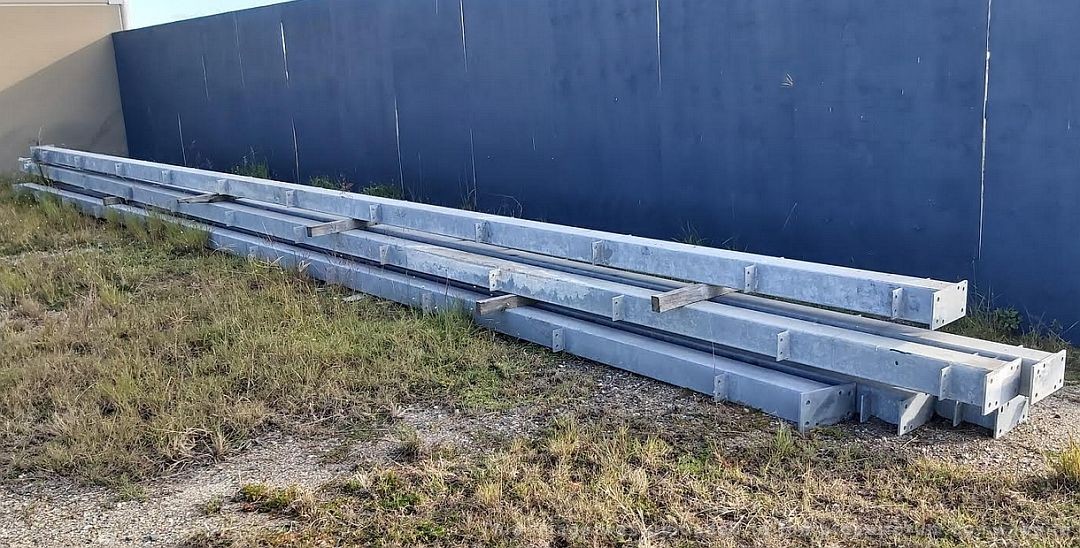
|
Total Posts: 2200 | Joined:
Dec 21, 2006 - 1:30am | IP
Logged
|
|
 |
Jerry Gilmartin |

TOP BOSS

|
   
 

  Posted on: Jun 20, 2021 - 3:15pm Posted on: Jun 20, 2021 - 3:15pm
|
Hello Paul, I dont really have the answers to most of your questions except for two of them. The first one, question #4 about the Higgins 78 foot 50 cal turrets vs the Elco 80 ft turrets being offset and how it relates to broadside firepower. So the design of the 78 foot Higgins was not too far from the 77 foot Elco design. As you may recall, the 77 foot Elco had its 50 cal turrets next to each other just like the Higgins design. The Elco 80 footer was a complete redesign, and perhaps the Higgins Company was asked, but declined to redesign their entry to match the Elco changes. I get the feeling that is not how Government contracts worked. Higgins just chose to stick to the original setup that was accepted by the Navy for the Plywood Derby. I imagine there was some friendly competitive spirit between these 2 companies, and they would not take kindly to being ordered to adapt their competitors designs into their own boat. It would be like the Government telling Ford to start installing the Onstar Navigation System (patented by General Motors) into their Ford autos. It is an unacceptable change, and was not in the contract, so it was not installed.
The other question (#6) I can answer is about the WW2 PT Boats not having a remote gear shifting capability. I think I know exactly why. It is based upon the design of the Packard engine transmission. The Packard engine uses a Snow Nabstedt "Joes Gear" Transmission which is 3 position transmission. (forward, neutral and reverse). The shift lever takes about 70 foot-pounds of torque to place it into or out of gear. When the PT658, here in Portland, OR was first being operated in 2004, we installed some pneumatic cylinders in order to operate these shifters from the helm. That was a bad choice, since it created other problems. What happened was the constant shifting by the Skipper when coming into a dock was wearing down the transmissions extremely fast. We were having to replace the drive band on the reverse gear and other internal parts of the transmission way too often. Also, the guy up on the helm has no feedback from the engine when he is shifting. If the engine started to make noise or groan or bog down the helmsman cannot hear a thing. We developed the opinion that having the ability to shift remotely promoted "overshifting". The skipper has a learning curve of how to come into a dock properly without the necessity of constantly shifting into reverse or forward in quick succession. So we had to break the skipper of this bad habit, and train our motormacs to instantly respond to orders from the helm. Our learning curves resulted in several unplanned high speed meetings between the boat and dock! One of our former skippers Chuck Kellogg told me once that you only want to approach the dock in the PT Boat as fast as you want to collide with it! So we removed those remote shifter cylinders only about 1 year after installing them to help keep our engines running better. Another bad thing about the pneumatic cylinders was they required constant adjustment, and would not place the engine completely into gear, or it would sometimes pop out of gear under a strain. So our crew decided we should just stick to the original WW2 method of having the motormac down in the engine room do the shifting and the skipper would just operate the signals for what he wanted to do. We also added a flashy light and a loud buzzer to get the attention of the motormac in the engine room before ordering a shift, so they would be ready to shift gears as soon as the order is given. It is so loud down there they found the motormacs were missing orders sometimes.
Jerry
Jerry Gilmartin
PT658 Crewman
Portland OR |
Total Posts: 1472 | Joined:
Oct 8, 2006 - 11:16pm | IP
Logged
|
|
Dick

Moderator

|
   
 

  Posted on: Jun 21, 2021 - 4:01pm Posted on: Jun 21, 2021 - 4:01pm
|
Hi Paul . . .
I’ll try to answer some of your questions below.
Please note, my design and/or historical comments are my own, and are assumed by me, to be reasonable assumptions from what I have read/observed over time.
Hull Design of Elco boats only -
(Higgins and Huckins designs were different):
The designs of the late 30’s and 40’s were based on science, engineering, and experience at that time. It’s funny to look back, design engineering was calculate on “Slip-Sticks”, the trusty old slide rules we all learned on, not computers and calculators. Engineering was pencil on paper, not ultra sophisticated 3D and CAD computers, software with analytical abilities, and 3D printers. Just think how simple it would be to make multiple hull mock-up with all types of varying design aspects and test float them . . . something that couldn’t be imagined back then.
CORRECTION: I misidentified the boat that was actually purchased by Elco. It was actually a copy of the PV70, ordered by Elco and identified as the MTB-ELCO. The actual PV70 was send to Canada, where it spent the war year being renumbered and reclassified several time. For some reason it was returned to the US Navy at the war’s end. - (Special thanks to Al and Andy for their help )
The sentence below should have read: The first Elco boats, PT 10-19 and PTC 1-12, were 70-foot boats based closely on the design of a purchased copy of the PV70 boat from BPB of Great Britain . . . . .
The first Elco boats, PT 10-19 and PTC 1-12, were 70-foot boats based closely on the design of the purchased PV70 boat, from Great Britain.
This PV70 boat was a new design from Hubert Scott-Paine’s British Power Boat Company. With the design featuring a low boat profile, a planning hull, hard chine, and a curved gunwale , see photos below.
Photo PV70 (PT 9)
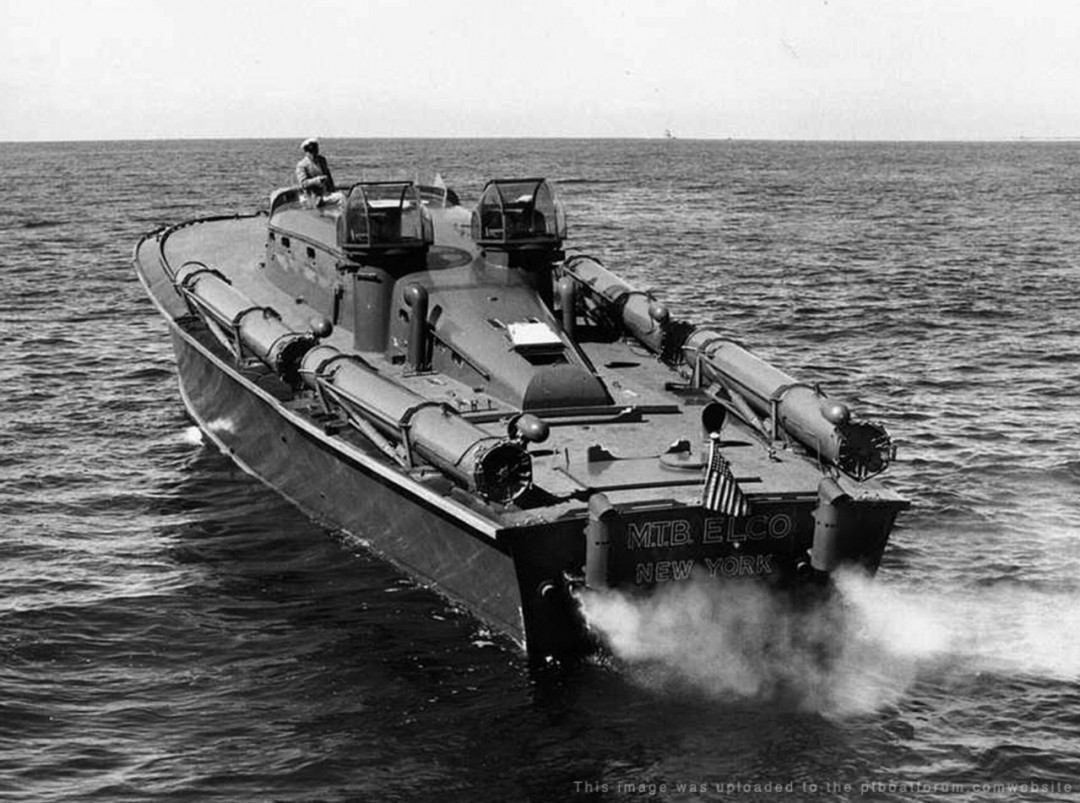
Photo of PT 9 (PV70)
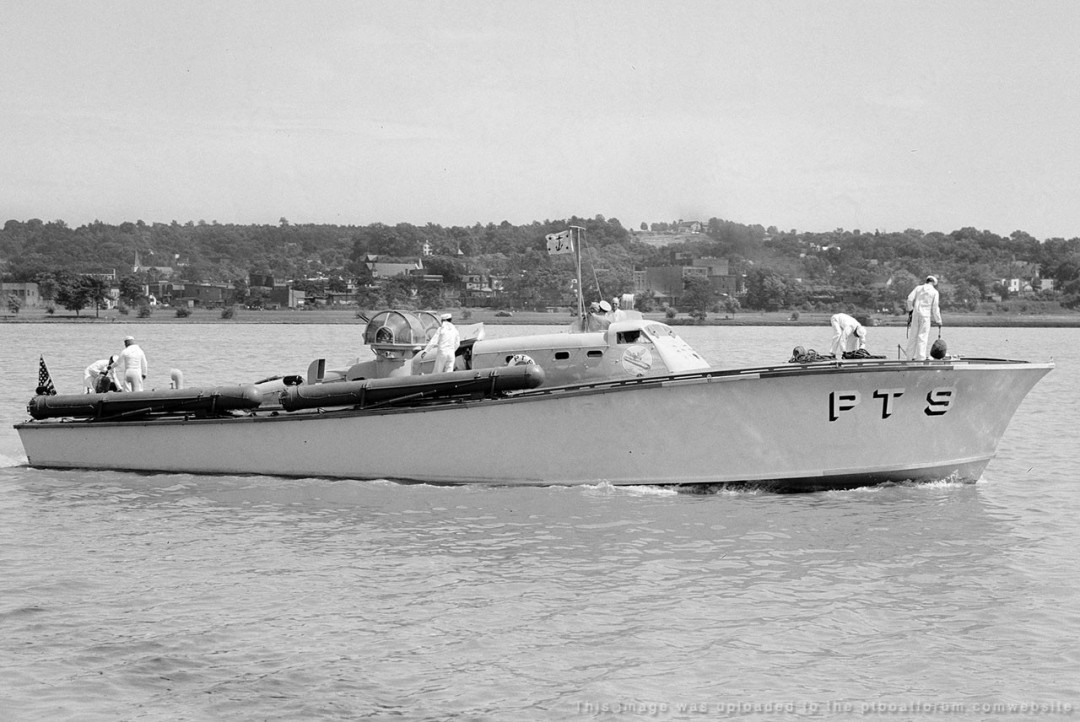
It was his belief that it would be a sea worthy fast motor boat which could be applied to war type uses. The design is discussed in detail in his two patents, which pretty much replicated by his PV70 boat. These patents can be easily found on the internet for the United States, Canada or even Great Britain. But, are included below:
Click on the links to download a copy of the patent:
http://www.ptboatforum.com/HubertScott-Paine-001.pdf
Reference: See Page 5 of the pdf, or actual page 2 of the text portion, at Line 20-Left
And an accompanied patent:
http://www.ptboatforum.com/HubertScott-Paine-002.pdf
Although the Elco 70’s varies a little from the original PV70 design, (renumbered by the US Navy as PT 9) it is pretty much copied, except for the bridge and trunk cabin changes.
Photo of Elco’s first series of 70ft boats, PT 12.
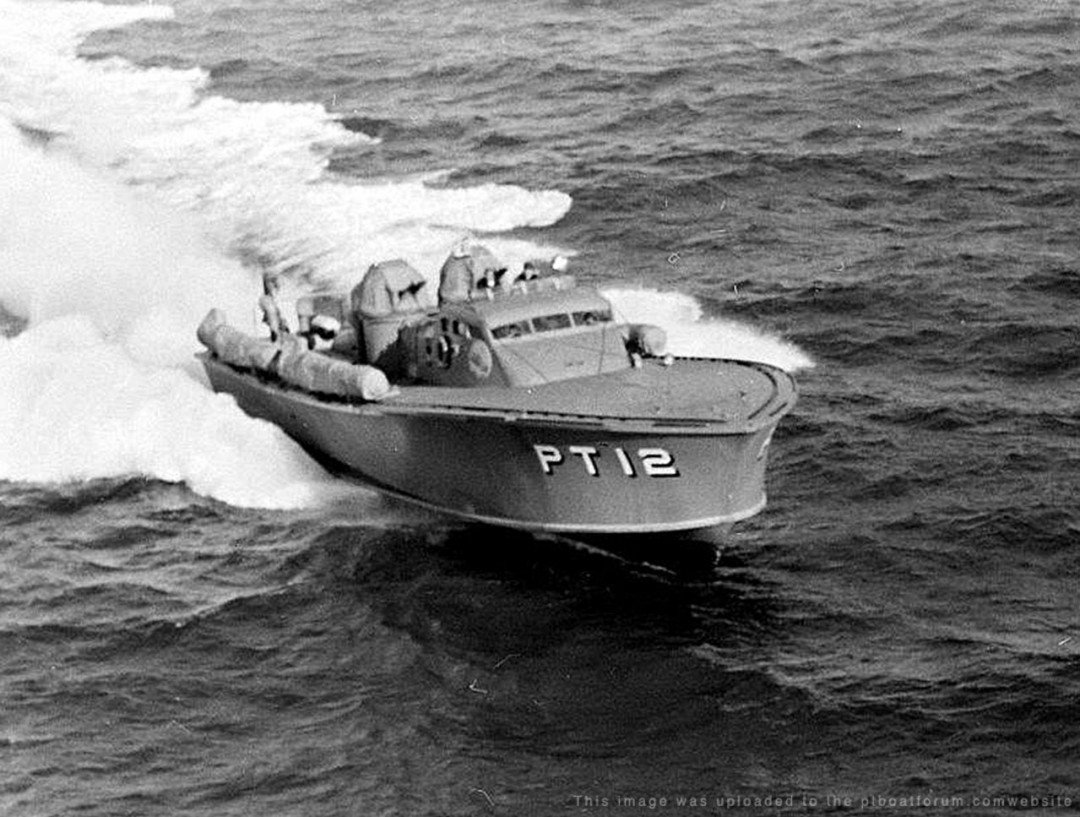
Along with the 70-foot boats, the Elco designs of the 77-foot and 80-foot boats appeared to keep the same style hull structure.
Higgins Gun Turret Placement:
All three American motor torpedo boats designs were based on each companies own design philosophy and concepts for the boats. In some cases the Navy dictated some specific aspects. As is the case with Higgins. The first Higgins boats contracted were PT 71-94 and were being built as shown in the first two photos below:
Photo of early Higgins Design PT 80 launched.
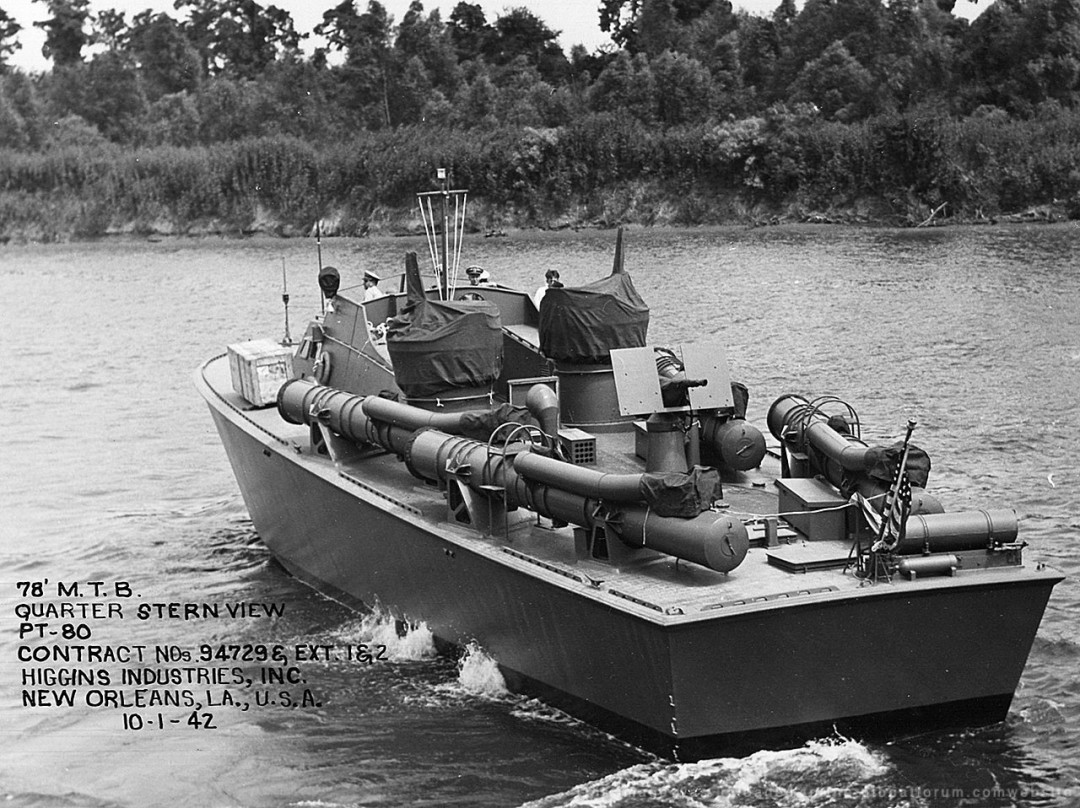
Photo of Higgins factory floor with first early design boats, PT 84, 87, 88.
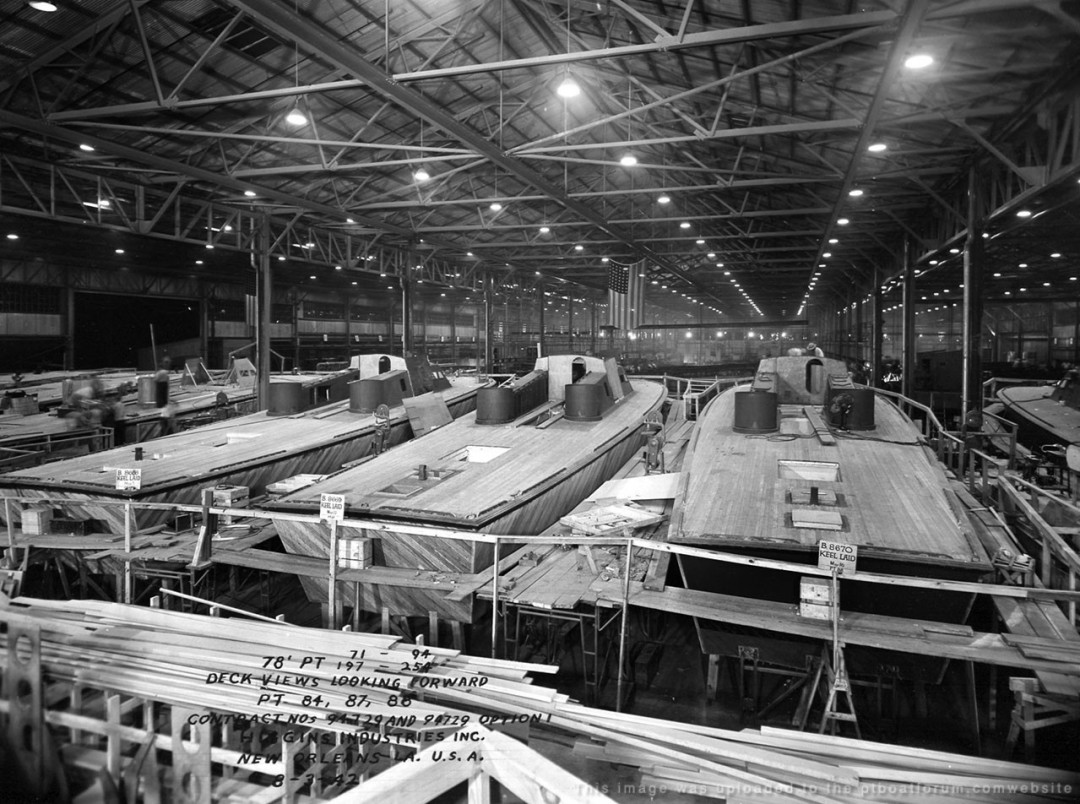
NO CORRECTION REQUIRED
As can bee seen, the Higgins boats had long deck structures extending aft from the bridge. Located at the aft ends of these two structures were gun turrets. As seen, the turrets were offset and not aligned with each other. The starboard side turret was closer to the bridge than the turret on the port side. I have no knowledge why the turret were offset, maybe firing positions. Regardless, the Navy rejected the first boats delivered, because of this turret placement and there inability to fire forward on attack. Higgins was order to moved the turrets forward next to the bridge, and placed in alignment with each other. Also the removal of the extended structures. This can be seen in the photos of the documents below:
Photos of Higgins boat configuration change request,
Document page 1.

Document page 2.

Photo of PT 87, boat launch with reconfigured design.
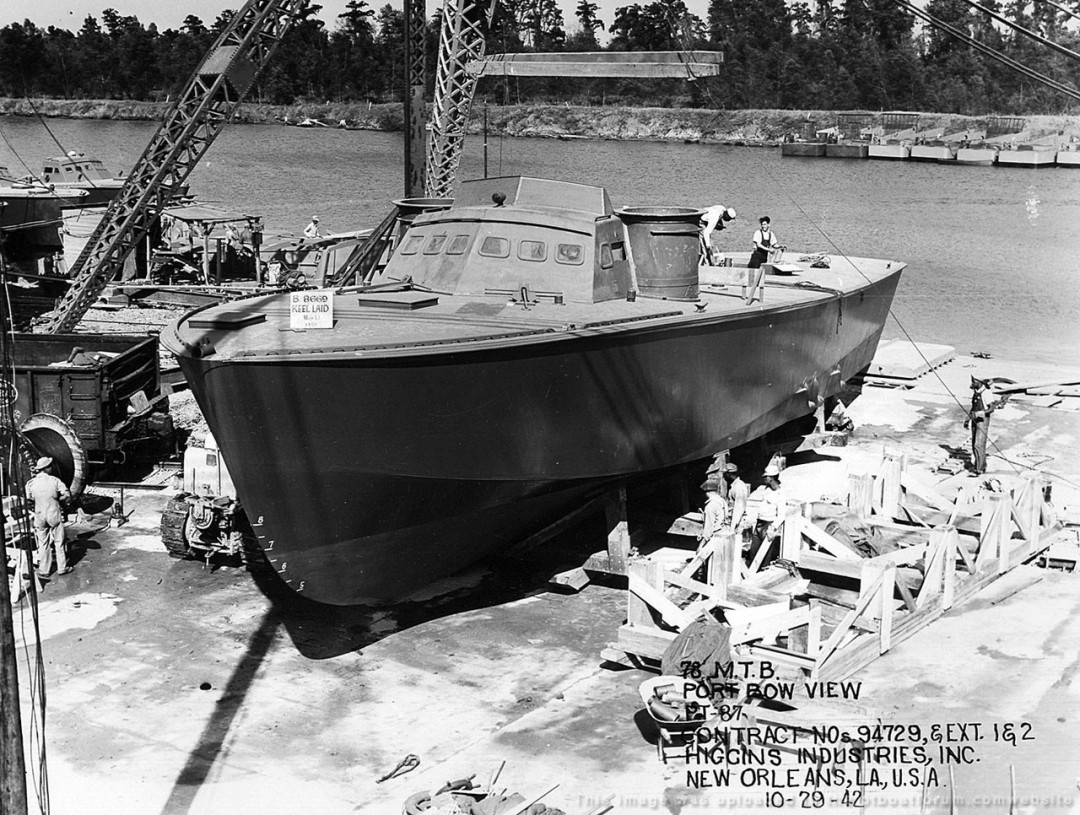
Thank you for the kind words about my cutaway artwork,
Dick . . .
|
Total Posts: 1417 | Joined:
Aug 27, 2006 - 6:36pm | IP
Logged
|
|
Stearman

Advanced Member

|
   
 
 Posted on: Jun 21, 2021 - 9:00pm
Posted on: Jun 21, 2021 - 9:00pm
|
Dick, you will probably get a kick out of this, with machines designed with slide rules. Back in the late 80s, an airplane company called Christen noticed that the Piper Cub was about to celebrate its 50th anniversary. They thought, surely with modern computers they could do better! Every time they put in the paramotors for the new plane, the CAD would spit out the drawings for a Super Cub. People have tried the same thing with modern computers with the same results, a Super Cub, with all the later STOL mods developed in the 60s and 70s. Hard to beat perfection! I was trained to use slide rules as late as the mid 70s, need a backup for when your batteries fail on the calculator. I still pull them out to see what I still remember.
|
Total Posts: 150 | Joined:
Nov 1, 2017 - 9:38pm | IP
Logged
|
|
Andy Small

MASTER

|
   
 
 Posted on: Jun 22, 2021 - 5:26am
Posted on: Jun 22, 2021 - 5:26am
|
For understanding the BPB and Elco hull design and construction I recommend three books. Race Against The Odds by Kevin Desmond, which covers the early BPB design influence of Fred Cooper. Fast Boats and Flying Boats by Adrian Rance which covers BPB, and last, the Bible of PT Boat design, Naval Architecture of Planing Hulls by Lindsay Lord.
As to initial .50 cal gun placement, BuShips heavily influenced the placement. I know they had Huckins move his turrets aft and inboard, he had them in similar configuration as used for PT-69. I believe they also did that with Higgins, although I don't have actual documentation on that one. Believe much of the gun placement had to do with the most stable location as an AA battery, and less to do with attacking surface vessels since the main weapon was suppose to be torpedoes and not short range guns.
|
Total Posts: 262 | Joined:
Nov 20, 2013 - 9:04pm | IP
Logged
|
|
Dick

Moderator

|
   
 

  Posted on: Jun 22, 2021 - 2:06pm Posted on: Jun 22, 2021 - 2:06pm
|
Stearman . . .
Funny . . .
My slide rule antics go back to 1965 when all I could afford was one those $19 ABS plastic ones. These baby's were so inaccurate I was threatened by instructor that he would not give me a grade unless I got a real one! ! ! ! Later that year, and very fortunate for me, my brother-in-law to-be, who was attending Oregon State University and enrolled in their engineering program, decided he didn’t like engineering and changes his major. The fortunate part, was he gifted me his $140 solid bamboo professional, “Post,” slide rule. What a treasure for me, it would have been completely impossible for me to gather any similar amount even a much lessor amount of money for such a devise. I would now, probably get a grade from my Advance Analytical Math class.
Below, is my old trusty slide rule, I should say Tom’s (may he rest in peace) trusty slide rule. While looking at it today, I can barely read the scales, and 66 years later not sure what side or end to start on - oh how the brain goes when we get older.
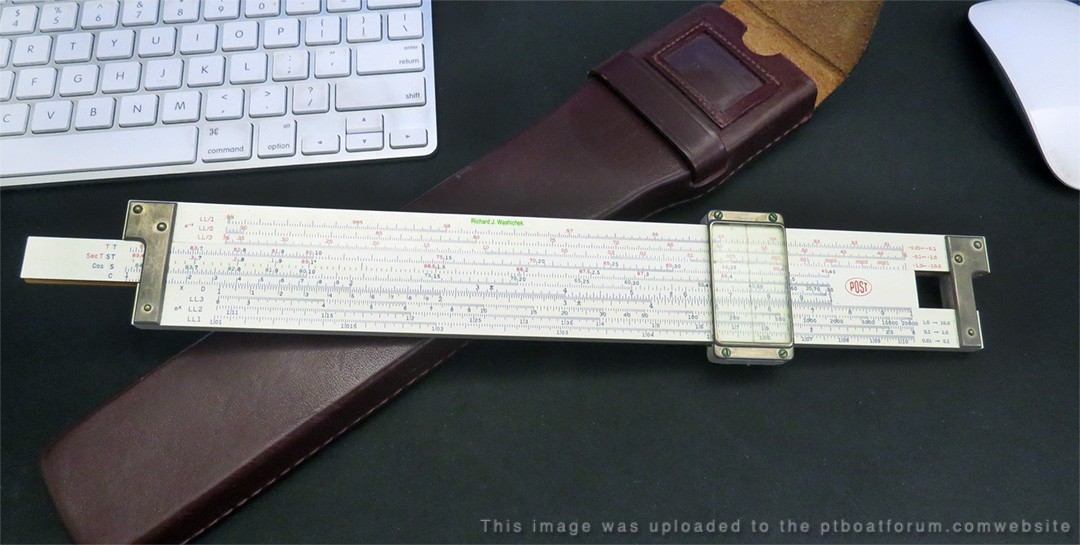
|
Total Posts: 1417 | Joined:
Aug 27, 2006 - 6:36pm | IP
Logged
|
|
Dick

Moderator

|
   
 

  Posted on: Jun 22, 2021 - 2:14pm Posted on: Jun 22, 2021 - 2:14pm
|
Andy . . .
I will look into the errors and correct the post as needed. I had sourced several well known books and a dozen or so internet articles on the matter and had assumed they were correct.
Thanks,
Dick . . . .
|
Total Posts: 1417 | Joined:
Aug 27, 2006 - 6:36pm | IP
Logged
|
|
Stearman

Advanced Member

|
   
 
 Posted on: Jun 22, 2021 - 9:43pm
Posted on: Jun 22, 2021 - 9:43pm
|
Dick, that is a great story, sometimes we all get lucky. I pulled out one of my small slide rules, on the back it says, Keuffel & Esser Co. and in large letters, Beginner's Slide Rule! Oh well, it tot me the basic's.
|
Total Posts: 150 | Joined:
Nov 1, 2017 - 9:38pm | IP
Logged
|
|
Jeff D

Moderator

|
   
 

  Posted on: Jun 23, 2021 - 6:26am Posted on: Jun 23, 2021 - 6:26am
|
Hey Andy, good to hear from you! Thanks, I too thought that PV 70 was the future PT 9...
I had to buy one of those cheap plastic slide rules also Dick, for a HS math class. I don't remember ever using it in class, maybe the teacher's brother-in-law had a corner on the local slide rule market and teach was helping him out.
|
Total Posts: 2200 | Joined:
Dec 21, 2006 - 1:30am | IP
Logged
|
|
Jeff D

Moderator

|
   
 

  Posted on: Apr 14, 2022 - 12:45pm Posted on: Apr 14, 2022 - 12:45pm
|
Paul sent an update, he's starting the mammoth task of wiring. I agree with him, Gulp!:
Just a quick update on the model boat project.
Late nite here in OZ.
Coffee.... CCR and Beach Boys blasting.
Working on SOME of the wiring looms.
80 foot boat looms make an F150 loom childs play.
These panels are for chartroom - engineer/motormac control.
A LOT more wiring to go!
Next month getting the 2 x Caterpillar V12, twin turbo engines shipped to Cat workshop for dyno tuning.
Wind 'em up .
Best have my plastic card at the ready for that.
Gulp!
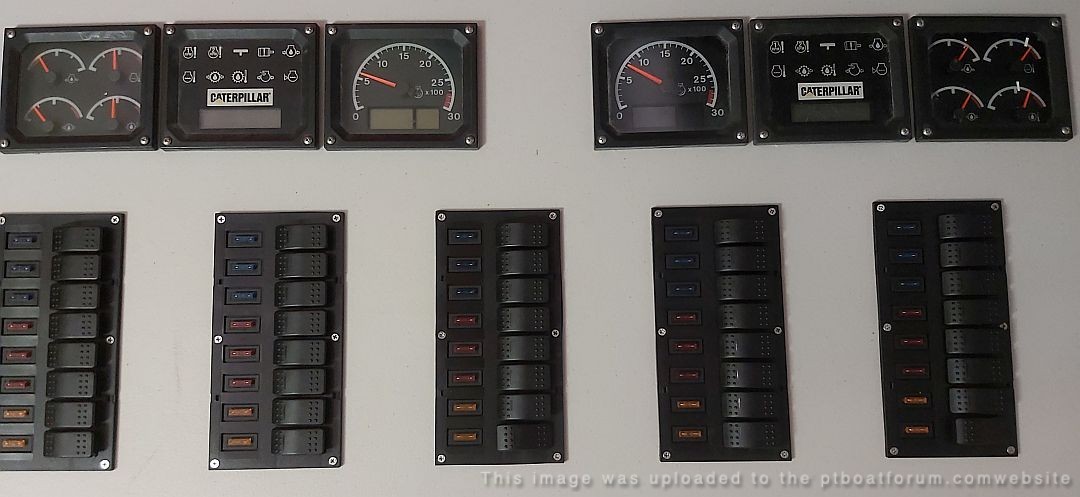
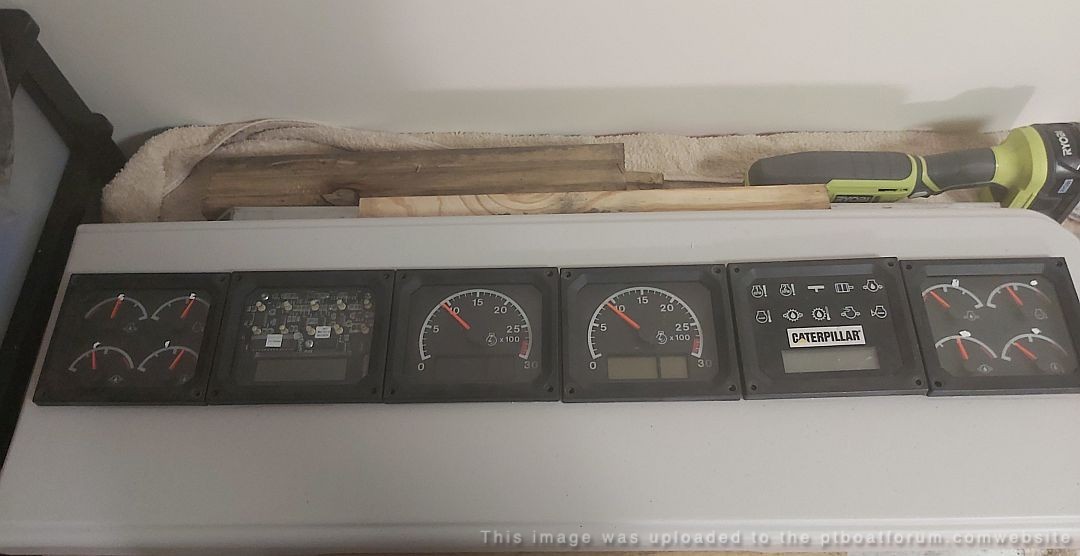
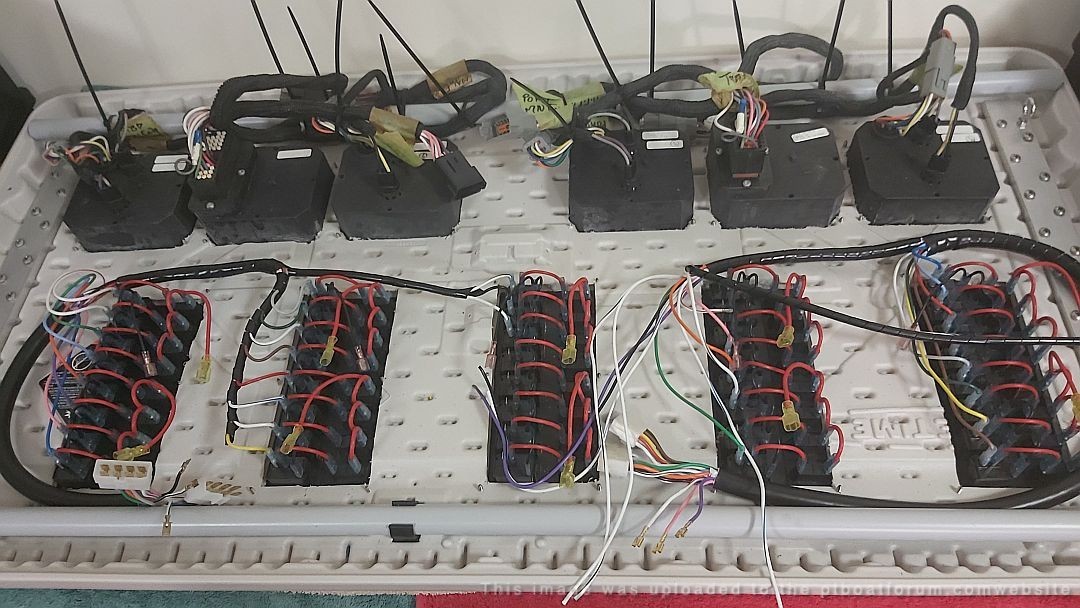
|
Total Posts: 2200 | Joined:
Dec 21, 2006 - 1:30am | IP
Logged
|
|
|
































